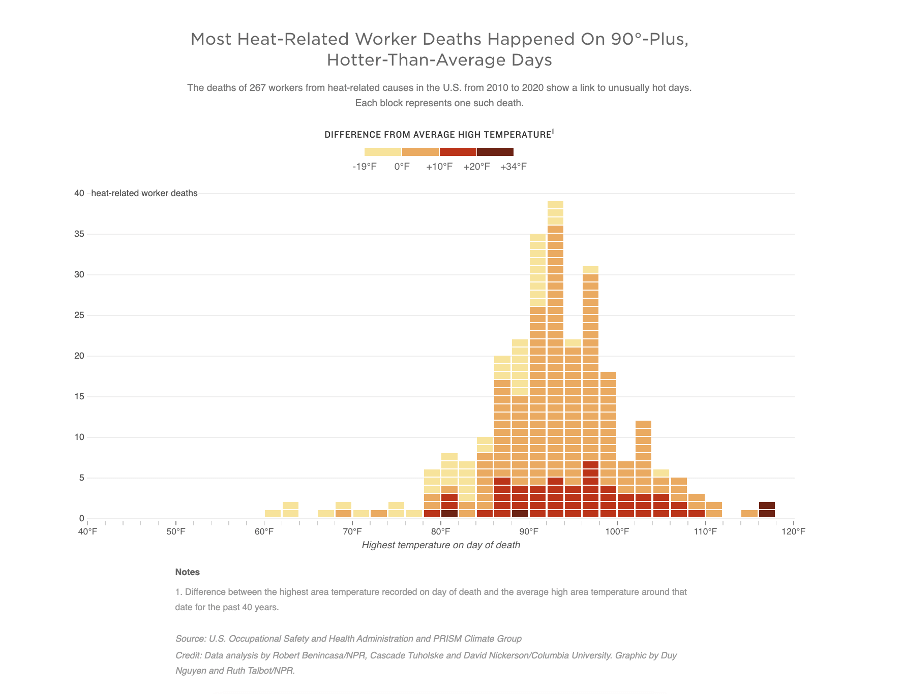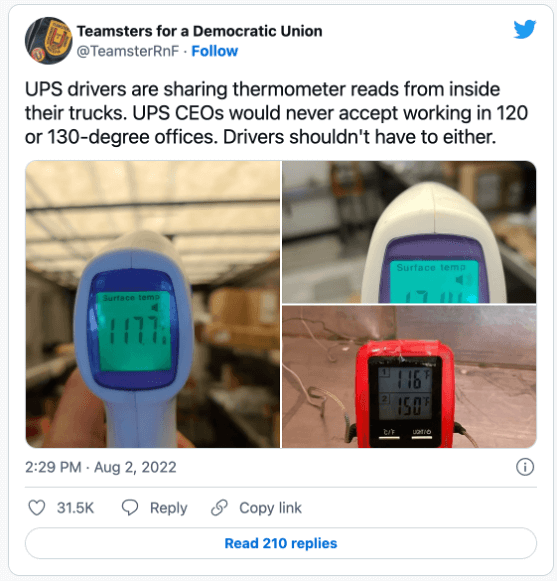 |
Written by Liz McDermott |

It’s the hottest year in history. As we continue to experience extreme heat across the globe and everyone tries to keep cool, some workers don’t have much of a choice but to endure the heat. This June, a 24-year-old UPS driver died while delivering packages on a hot day in the Los Angeles area. On social media, we see drivers sharing the temperature inside delivery trucks with thermometer digits showing unbearable temperatures.
Last year, NPR reporters analyzed worker heat deaths recorded by OSHA between 2010 and 2020 and compared each incident day's high temperature with historical averages over 40 years. Most of the deaths happened on days that were unusually hot for that date. More than two-thirds occurred on days when the temperature reached at least 90 degrees.

Employers are Responsible for Protecting Workers from Heat Illness
By law, employers are responsible for providing workplaces free of known safety hazards, including extreme heat. It is your company’s responsibility to:
- Provide workers with water, rest, and shade.
- Allow new or returning workers to gradually increase workloads and take more frequent breaks during the first week of work as they build a tolerance for working in the heat.
- Plan for emergencies and train workers on prevention.
- Monitor workers for signs of illness.
Signs and Symptoms of Heat Illness
People adjust to heat differently. It takes most young, healthy individuals 14 days to fully acclimate to the hot weather if they increase their exposure to it. People who don't exercise regularly and who are not used to strenuous activity may take longer to adapt. When heat is extreme, it makes it harder for anyone to adjust, which is why it is super important for workers to be able to recognize the signs and symptoms associated with heat illness.
Sunburn is characterized by redness, soreness, swelling of the skin, blisters, fever, and headaches. Ointments should be applied to treat mild burns and to prevent blisters from breaking. If they do break, apply a dry, sterile dressing.
Heat cramps are painful spasms in the lower leg and abdominal muscles accompanied by heavy sweating. If cramps occur, apply firm pressure or gentle massage to relieve them. Water may be offered to the victim in small sips if nausea does not occur. If nausea does occur, stop providing water.
Heat exhaustion is characterized by heavy sweating, weakness, cold, pale, clammy skin, thready pulse, fainting and vomiting, but normal body temperature. When the victim is removed from the sun, he or she should be placed in a horizontal position and have his or her clothing loosened. Cold, wet cloths should be applied. If vomiting or nausea occurs, the victim should be moved to an air-conditioned room. Heat exhaustion requires immediate medical attention. If you observe someone with heat exhaustion, seek medical help immediately.
Heat stroke is the most severe heat-related illness and requires urgent medical attention. Heat stroke symptoms may include confusion, redness of the skin, hot and dry skin, lack of sweating, and very high body temperature (above 103° F).
Conclusion: Steps to Prevent Heat Illness
Extreme summer heat waves can be hazardous. The brain and other critical organs can be damaged if the body's temperature is excessively high. Some diseases, particularly old age, obesity, fever, dehydration, heart disease, poor circulation, sunburn, and drug and alcohol consumption, may make it more difficult for the body to cool down when it's hot out. To safeguard your health when temperatures are high, follow these guidelines:
- Drink water and take frequent breaks to prevent overheating.
- Work up to heavy tasks in hot weather slowly.
- Avoid working excessively hard in warm weather, particularly if you're a newbie or haven't worked in a while.
- Workers who are new to outdoor heat or have been absent from work for a long time should begin by increasing efforts gradually and take more regular breaks.
- If possible, postpone or cancel physically demanding activities until the coolest time of day. Wear light-colored, lightweight clothing to prevent overheating and sun damage.
- Certain foods, such as meat, which increase metabolic heat production, cause water loss.
- Drink plenty of nonalcoholic, decaffeinated fluids and water, as your body requires it to cool off.
- Download a heat index app to plan outdoor work activities based on how hot it feels throughout the day.
For more information, please contact us to inquire about our safety training programs.

